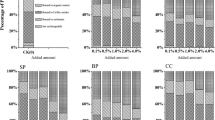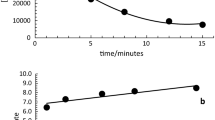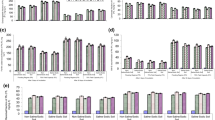Abstract
Pb can be stabilized in soil as Pb-P mineral. The aims of this study were to access the distribution of Pb in organic and mineral fractions of contrasting texture of soil Pb-contaminated and remediated with P and Cl and to evaluate the stability of chloropyromorphite in these soils. A clay loam Oxisol (sandstone) and a clayey Ultisol (basalt) were used in a factorial experiment, with three replications: two soils, two Pb contamination levels, two soil pH values, and four P doses. The Pb concentrations were determined in seven soil phases. Release kinetics of Pb were performed with 0.1 mol L−1 pH 2.5 citric acid. The transfer of soil Pb to chloropyromorphite was dependent on the level of contamination in the clay loam Oxisol. In the lowest P dose (molar ratios P:Pb 3:5), the main source was the Pb complexed in the organic matter and in the highest P dose (molar ratios P:Pb 12:5) was the Pb adsorbed by inner sphere in gibbsite and kaolinite. The release of Pb in the citric acid was dependent on the texture and mineralogy of the soils. Pb recovery applied to the clay loam Oxisol was around 100% (biphasic kinetic), while for the clayey Ultisol, the recovery ranged from 43 to 52% (single-phase kinetic). Remediation of Pb-contaminated soils with P and Cl is more efficient in clayey and oxidic soils since chloropyromorphite formation is faster and its solubilization is slower, an important combination in environmental terms.



Similar content being viewed by others
References
Alleoni, L. R. F., Mello, J. W. V., & Rocha, W. S. D. (2009). Electrochemistry, adsorption and ion exchange of soil. In V. F. Melo & L. R. F. Alleoni (Eds.), Soil chemistry and mineralogy (pp. 70–129). Viçosa: Sociedade Brasileira de Ciência do Solo.
Austruy, A., Shahid, M., Xiong, T., Castrec, M., Payre, V., Niazi, N. K., Sabir, M., & Dumat, C. (2014). Mechanisms of metal-phosphates formation in the rhizosphere soils of pea and tomato: environmental and sanitary consequences. Journal of Soils and Sediments, 14, 666–678. https://doi.org/10.1007/s11368-014-0862-z.
Borges, E.A., Loss, A., Silva, E.E., Souza, S.R., Fernandes, M.S., 2009. Ammonium absorption kinetics and proton efflux in corn varieties. Semina 30, 513–526.
Bosso, S. T., Enzweiler, J., & Angélica, R. S. (2008). Lead bioaccessibility in soil and mine wastes after immobilization with phosphate. Water, Air, and Soil Pollution, 195, 257–273. https://doi.org/10.1007/s11270-008-9744-6.
Buschle, B. N., Palmeiro, J. K., Sade, Y. B., Melo, V. F., Andrade, M. G., & Batista, A. H. (2010). Lead release kinetics of soils from heavy metal mining area. Revista Brasileira de Ciencia do Solo, 34, 1864–1874. https://doi.org/10.1590/S0100-06832010000600010.
Chaves, E., Pedron, F. A., Melo, V. F., & Dalmolin, R. S. D. (2015). K mineral reserve by different methods in subtropical Ultisols. Revista Brasileira de Ciencia do Solo, 39, 1088–1099. https://doi.org/10.1590/01000683rbcs20140670.
Debela, F., Arocena, J. M., Thring, R. W., & Whitcombe, T. (2010). Organic acid-induced release of lead from pyromorphite and its relevance to reclamation of Pb-contaminated soils. Chemosphere, 80, 450–456. https://doi.org/10.1016/j.chemosphere.2010.04.025.
Duarte, A. P., Melo, V. F., Brown, G. B., & Pauletti, V. (2012). Changes in the forms of lead and manganese in soils by passage through the gut of the tropical endogeic earthworm (Pontoscolex corethrurus). European Journal of Soil Biology, 53, 32–39. https://doi.org/10.1016/j.ejsobi.2012.08.004.
Gu, X., Sun, J., & Evans, L. J. (2014). The development of a multi-surface soil speciation model for Cd (II) and Pb (II): Comparison of two approaches for metal adsorption to clay fractions. Applied Geochemistry, 47, 99–108. https://doi.org/10.1016/j.apgeochem.2014.05.014.
Hashimoto, Y., Takaoka, M., Oshita, K., & Tanida, H. (2009). Incomplete transformations of Pb to pyromorphite by phosphate-induced immobilization investigated by X-ray absorption fine structure (XAFS) spectroscopy. Chemosphere, 76, 616–622. https://doi.org/10.1016/j.chemosphere.2009.04.049.
Hettiarachchi, G., & Pierzynski, G. (2000). The use of phosphorus and other soil amendments for in situ stabilization of soil lead. In Proceedings of the 2000 Conference on Hazardous Waste Research (pp. 125–133).
Kahkha, M. R., Bagheri, S., Noori, R., Piri, J., & Javan, S. (2017). Examining total concentration and sequential extraction of heavy metals in agricultural soil and wheat. Polish Journal of Environmetal Studies, 26, 2021–2028. https://doi.org/10.15244/pjoes/67658.
Karna, R., Noerpel, M., Luxton, T., & Scheckel, K. (2018). Point of zero charge: role in pyromorphite formation and bioaccessibility of lead and arsenic in phosphate-amended soils. Soil System, 2, 1–22. https://doi.org/10.3390/soilsystems2020022.
Koo, B.-K., Chang, A. C., Crowley, D. E., & Page, A. L. (2006). Characterization of organic acids recovered from rhizosphere of corn grown on biosolids-treated medium. Communications in Soil Science and Plant Analysis, 37, 871–887. https://doi.org/10.1080/00103620600564158.
Lindsay, W. L. (1979). Chemical equilibria in soils. New York: John Wiley and Sons.
Ma, L., Xu, R., & Jiang, J. (2010). Adsorption and desorption of Cu(II) and Pb(II) in paddy soils cultivated for various years in the subtropical China. Journal of Environmental Sciences, 22, 689–695. https://doi.org/10.1016/S1001-0742(09)60164-9.
Melo, É. E. C., Nascimento, C. W. A., Santos, A. C. Q., & Silva, A. S. (2008). Availability and fractionation of Cd, Pb, Cu and Zn as a function of pH and soil incubation time. Ciencia e Agrotecnologia, 32, 776–784. https://doi.org/10.1590/S1413-70542008000300011.
Melo, V. F., Corrêa, G. F., Ribeiro, A. N., & Maschio, P. A. (2005). Potassium and magnesium release kinetics by the clay fraction minerals of Triangulo Mineiro soils. Revista Brasileira de Ciencia do Solo, 29, 533–545. https://doi.org/10.1590/S0100-06832005000400006.
Pontoni, D. R., Melo, V. F., Stipp, R. D., Borgo, J. D. H., & Bonfleur, E. J. (2020). Integrated assessment of the liquid and solid phases of lead-contaminated soils remediated with phosphate. Geoderma, 360, 113993. https://doi.org/10.1016/j.geoderma.2019.113993.
Ryan, J. A., Zhang, P., Hesterberg, D., Chou, J., & Sayers, D. E. (2001). Formation of chloropyromorphite in a lead-contaminated soil amended with hydroxyapatite. Environmental Science & Technology, 35, 3798–3803. https://doi.org/10.1021/es010634l.
Salman, S., Abu El Ella, E., & Elnazer, A. (2018). Sequential extraction of some heavy metals in Southwest Giza Soil, Egypt. Egyptian Journal of Chemistry, 61, 785–797. https://doi.org/10.21608/ejchem.2018.3180.1271.
Santos, S.R., Silva, E.B., Alleoni, L.R.F., Grazziotti, P.H., 2017. Citric acid influence on soil phosphorus availability. J Plant Nutrition 40, 2138–2145.
Scheckel, K. G., & Ryan, J. A. (2002). Effects of aging and pH on dissolution kinetics and stability of chloropyromorphite. Environmental Science & Technology, 36, 2198–2204. https://doi.org/10.1021/es015803g.
Schwertmann, U., & Taylor, R. M. (1989). Iron oxides. In J. B. Dixon & S. B. Weed (Eds.), Minerals in soil environments (pp. 379–438). Madison: Soil Science Society of America.
Seshadri, B., Bolan, N. S., Choppala, G., Kunhikrishnan, A., Sanderson, P., Wang, H., Currie, L. D., Tsang, D. C. W., Ok, Y. S., & Kim, G. (2017). Potential value of phosphate compounds in enhancing immobilization and reducing bioavailability of mixed heavy metal contaminants in shooting range soil. Chemosphere, 184, 197–206. https://doi.org/10.1016/j.chemosphere.2017.05.172.
Sobrinho, N. M. B. A., Barra, C., & Lã, O. (2009). Heavy metal chemistry in soil. In V. F. Melo & L. R. F. Alleoni (Eds.), Soil chemistry and mineralogy (pp. 249–312). Viçosa: Sociedade Brasileira de Ciência do Solo.
Tarì, G., Bobos, I., Gomes, C. S. F., & Ferreira, J. M. F. (1999). Modification of surface charge properties during kaolinite to halloysite-7Å transformation. Journal of Colloid and Interface Science, 210, 360–366. https://doi.org/10.1006/jcis.1998.5917.
Xie, L., & Giammar, D. E. (2007). Equilibrium solubility and dissolution rate of the lead phosphate chloropyromorphite. Environmental Science & Technology, 41, 8050–8055. https://doi.org/10.1021/es071517e.
Wei, J., Duan, M., Li, Y., Nwankwegu, A. S., Ji, Y., & Zhang, J. (2019). Concentration and pollution assessment of heavy metals within surface sediments of the Raohe Basin, China. Scientific Reports, 9, 13100. https://doi.org/10.1038/s41598-019-49724-7.
Author information
Authors and Affiliations
Corresponding author
Additional information
Publisher’s note
Springer Nature remains neutral with regard to jurisdictional claims in published maps and institutional affiliations.
Rights and permissions
About this article
Cite this article
Pontoni, D.R., Melo, V.F., Stripp, R.D. et al. Lead-contaminated soils with contrasting texture remediated with phosphate: chemical fractionation and chloropyromorphite stability. Environ Monit Assess 192, 327 (2020). https://doi.org/10.1007/s10661-020-08256-8
Received:
Accepted:
Published:
DOI: https://doi.org/10.1007/s10661-020-08256-8




